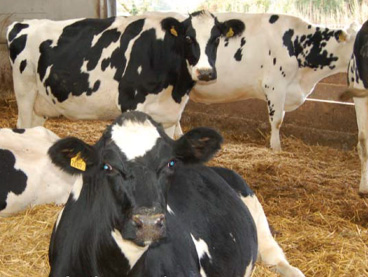Getting cows in calf quickly is even more challenging.
Good fertility key to production efficiency
With more milk buyers looking for a milk production prolife based on last year actual, getting cows in calf quickly is even more challenging as UFAC’s Mike Chown explains.
Achieving good fertility is important to maximise feed efficiency, annual milk yield and calf income. But it is taking on a new importance this year. To reduce spring milk production, many dairy companies are writing to producers explaining that a lower price will be paid for increased production in the spring. This makes it essential to ensure calving pattern does not slip.
Achieving good levels of fertility at grazing can be a challenge as intakes can vary due to grass DM changes and availability. Also, cows are possibly not observed as well. In addition, grazed grass does not contain the principal Omega 3’s fatty acids, EPA and DHA, which play a central role in fertility.
These specific Omega 3 fatty acids play two vital roles in dairy cow fertility particularly with regard to progesterone. The first role is ensuring a strong follicle which results in larger, more viable eggs with increased strength of bulling behaviour.
The second role is in reducing early embryo mortality. Early embryo loss is a major contributor to extended calving to conception intervals, reduced pregnancy rates and increased culling.
Dietary omega 3 fatty acids reduce levels of prostaglandin and stimulate higher levels of progesterone which reduces early embryo mortality. Ensuring cows are receiving the optimum levels of these specific fatty acids (15-20g/cow/day) will help reduce calving to conception interval.
Cows need to receive sufficient levels of these key fatty acids and in the correct ratio. To maximise fertility, the diet should contain omega 6: omega 3 in the ratio of 4:1.
The source of omega 3 is also very important. If the omega 3 is from vegetable sources (i.e. Alpha Linoleic acid – ALA) it has to be converted by the cow to EPA and DHA. This process is very inefficient and wastes energy. Best practice is to supply the cow directly with the EPA and DHA omega 3 fatty acids from marine sources in a rumen inert form.
UFAC Omega 3 Supplement is specially formulated to supply sufficient omega 3 EPA and DHA to rebalance omega 6 and omega 3 to an optimum 4:1 ratio. It is fed at 100g/day which is significantly lower than the feed rates required with supplements containing vegetable omega 3 fatty acids (ALA).
Supplementing your cows with EPA and DHA from marine sources will help ensure fertility remains at high levels while cows are at grazing, therefore, helping maintain more consistent milk production profiles.


 Back to News
Back to News 



